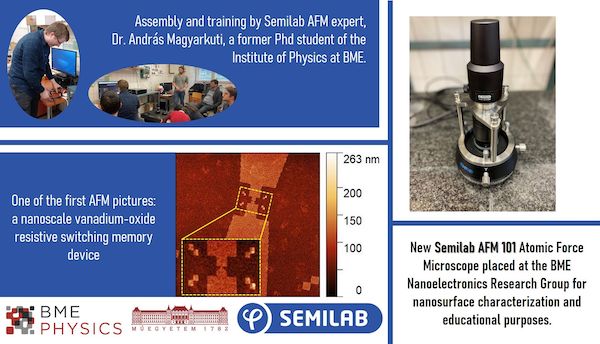Semilab AFM at the Institute of Physics
2022. May 31.



2022. May 31.


2022. May 19.
As a recognition of its top-quality research activities the BME Institute of Physics was awarded the `Institute of Excellence' title by the Hungarian Academy of Sciences.
News item at the page of the Hungarian Academy of Sciences (in Hungarian): https://mta.hu/kozgyules2022/mta-kivalo-kutatohely-nyilvanos-a-rangos-ak...

2022. May 19.
Leading European researchers of the field of semiconductor-superconductor hybrid systems gathered at BME, for the closing workshop of the SuperTop QuantERA network.
More details: https://dept.physics.bme.hu/SuperTop%20Workshop%202022?language=en
Page of the Quantum Electronics research group: https://nanoelectronics.physics.bme.hu/Quantum_intro

2022. May 14.
Sustained funding of the ELKH-BME Condensed Matter Physics Research Group, which covers a broad research spectrum and is led by András Halbritter, is awarded until June 2027.

2022. May 06.
Gergely Zaránd, head of the BME Institute of Physics, has been elected as a regular member to the Hungarian Academy of Sciences on May 3. Congratulations!
From the booklet issued by the Academy (pdf, in Hungarian):
"Gergely Zaránd was born in Budapest in1969. He has been the corresponding member of the Hungarian Academy of Sciences since 2016. He is a full professor at the Budapest University of Technology and Economics (BME), doing research in condensed-matter theory, studying strongly correlated quantum systems using the tools of quantum field theory and statistical physics.
He achieved seminal results in the areas of mesoscopic electronic systems, magnetic materials, and ultracold atoms. Since becoming a corresponding member, he has published more than 30 research papers, and the number of citations to his publications raised from 1800 to above 3000.
Highlights among his most recent results include the interpretation of electronic crystals (Wigner crystals), and the discoveries of extended Shiba states in superconductors, and topologically protected spin states in quantum dots. These results have yielded publications in Science and Nature. He has established an internationally recognised research unit in the Intitute of Physics of BME."
Gergely Zaránd was nominated to the membership of the Academy by Péter Domokos, András Jánossy, Katalin Kamarás, János Kertész, György Mihály, Jenő Sólyom.

2022. May 04.
Congratulations to András Bojtor (Dept. of Physics) and Dominik Szombathy (Dept. of Theoretical Physics) for winning the Cooperative Doctoral Programme scholarships.

2022. March 31.
Renown mathematician and historian delivers her lecture on `Penrose Tilings and the Imagination' at the BME Applied Mathematics Day on April 20, 15:00.
Registration: https://bit.ly/3tF4ZLJ
BME Applied Mathematics Day: https://math.bme.hu/alkmatnap-program-2022apr

2022. March 24.
Short video introducing the Quantum Information National Laboratory, featuring BME physicists Szabolcs Csonka, Ádám Gali, Máté Kedves, and Gergely Zaránd.
Quantum Lab on the web: https://qi.nemzetilabor.hu/

2022. March 23.
Are your bitcoins threatened by quantum computers? Our colleague János Asbóth reviews recent research from Sussex at the Hungarian science news outlet qubit.hu.

2022. March 22.
